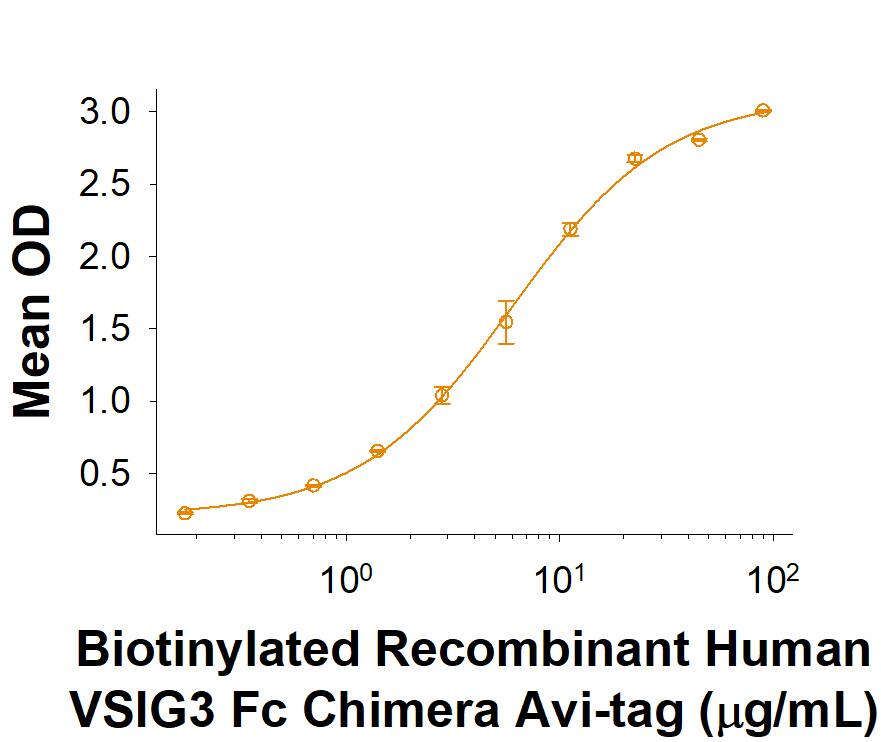Recombinant Human VSIG3 Fc Chimera Avi-tag Protein, CF
R&D Systems, part of Bio-Techne | Catalog # AVI9229
Biotinylated

Key Product Details
Learn more about Avi-tag Biotinylated Proteins
Source
CHO
Accession #
Structure / Form
Disulfide-linked homodimer, biotinylated via Avi-tag
Conjugate
Biotin
Applications
Bioactivity
Product Specifications
Source
Chinese Hamster Ovary cell line, CHO-derived human VSIG3 protein
| Human VSIG3 (Leu23-Gly245) Accession # Q5DX21.3 |
IEGRMD | Human IgG1 (Pro100-Lys330) |
Avi-tag |
| N-terminus | C-terminus | ||
Purity
>95%, by SDS-PAGE visualized with Silver Staining and quantitative densitometry by Coomassie® Blue Staining.
Endotoxin Level
<0.10 EU per 1 μg of the protein by the LAL method.
N-terminal Sequence Analysis
Leu23
Predicted Molecular Mass
52 kDa
SDS-PAGE
62-69 kDa, under reducing conditions
Activity
Measured by its binding ability in a functional ELISA.
When Recombinant Human VISTA/B7-H5/PD-1H Fc Chimera Protein (Catalog # 7126-B7) is immobilized at 2.5 μg/mL (100 μL/well), the concentration of Biotinylated Recombinant Human VSIG3 Fc Chimera Avi-tag (Catalog # AVI9229) that produces 50% of the optimal binding response is found to be approximately 3-15 μg/mL.
Measured by its ability to inhibit anti-CD3 antibody induced IL-17 or IFN-gamma secretion by human peripheral blood mononuclear cells (PBMC).
The ED50 for this effect is 1-10 μg/mL.
When Recombinant Human VISTA/B7-H5/PD-1H Fc Chimera Protein (Catalog # 7126-B7) is immobilized at 2.5 μg/mL (100 μL/well), the concentration of Biotinylated Recombinant Human VSIG3 Fc Chimera Avi-tag (Catalog # AVI9229) that produces 50% of the optimal binding response is found to be approximately 3-15 μg/mL.
Measured by its ability to inhibit anti-CD3 antibody induced IL-17 or IFN-gamma secretion by human peripheral blood mononuclear cells (PBMC).
The ED50 for this effect is 1-10 μg/mL.
Scientific Data Images for Recombinant Human VSIG3 Fc Chimera Avi-tag Protein, CF
Recombinant Human VSIG3 Fc Chimera Avi-tag Protein Binding Activity
When Recombinant Human VISTA/B7-H5/PD-1H Fc Chimera Protein (Catalog # 7126-B7) is immobilized at 2.5 µg/mL (100 µL/well), the concentration of Biotinylated Recombinant Human VSIG3 Fc Chimera Avi-tag (Catalog # AVI9229) that produces 50% of the optimal binding response is found to be approximately 3-15 µg/mL.Recombinant Human VSIG3 Fc Chimera Avi-tag Protein SDS-PAGE
2 μg/lane of Biotinylated Recombinant Human VSIG3 Fc Chimera Avi-tag (Catalog # AVI9229) was resolved with SDS-PAGE under reducing (R) and non-reducing (NR) conditions and visualized by Coomassie® Blue staining, showing bands at 62-69 kDa and 120-140 kDa, respectively.Formulation, Preparation and Storage
AVI9229
| Formulation | Supplied as a 0.2 μm filtered solution in PBS. |
| Shipping | The product is shipped with dry ice or equivalent. Upon receipt, store it immediately at the temperature recommended below. |
| Stability & Storage | Use a manual defrost freezer and avoid repeated freeze-thaw cycles.
|
Background: VSIG3
References
- Schreiber, J. et al. (2014) Adv. Neurobiol. 8:21.
- Suzu, S. et al. (2002) Biochem. Biophys. Res. Commun. 296:1215.
- Katoh, M. and M. Katoh (2003) Int. J. Oncol. 23:525.
- Raschperger, E. et al. (2004) J. Biol. Chem. 279:796.
- Harada, H. et al. (2005) J. Cell. Physiol. 204:919.
- Jang, S. et al. (2016) Nat. Neurosci. 19:84.
- Watanabe, T. et al. (2005) Cancer Sci. 96:498.
- Eom, D.S. et al. (2012) PLoS Genet. 8:e1002899.
Long Name
V-Set and Immunoglobulin Domain Containing 3
Alternate Names
BTIGSF, CXADRL1, IGSF11
Gene Symbol
IGSF11
UniProt
Additional VSIG3 Products
Product Documents for Recombinant Human VSIG3 Fc Chimera Avi-tag Protein, CF
Product Specific Notices for Recombinant Human VSIG3 Fc Chimera Avi-tag Protein, CF
For research use only
